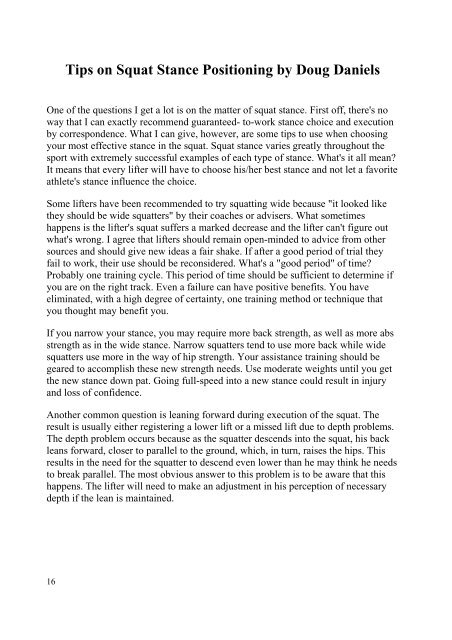June 2010 - Hamiltons Fitness Centre
June 2010 - Hamiltons Fitness Centre
June 2010 - Hamiltons Fitness Centre
Create successful ePaper yourself
Turn your PDF publications into a flip-book with our unique Google optimized e-Paper software.
Tips on Squat Stance Positioning by Doug DanielsOne of the questions I get a lot is on the matter of squat stance. First off, there's noway that I can exactly recommend guaranteed- to-work stance choice and executionby correspondence. What I can give, however, are some tips to use when choosingyour most effective stance in the squat. Squat stance varies greatly throughout thesport with extremely successful examples of each type of stance. What's it all mean?It means that every lifter will have to choose his/her best stance and not let a favoriteathlete's stance influence the choice.Some lifters have been recommended to try squatting wide because "it looked likethey should be wide squatters" by their coaches or advisers. What sometimeshappens is the lifter's squat suffers a marked decrease and the lifter can't figure outwhat's wrong. I agree that lifters should remain open-minded to advice from othersources and should give new ideas a fair shake. If after a good period of trial theyfail to work, their use should be reconsidered. What's a "good period" of time?Probably one training cycle. This period of time should be sufficient to determine ifyou are on the right track. Even a failure can have positive benefits. You haveeliminated, with a high degree of certainty, one training method or technique thatyou thought may benefit you.If you narrow your stance, you may require more back strength, as well as more absstrength as in the wide stance. Narrow squatters tend to use more back while widesquatters use more in the way of hip strength. Your assistance training should begeared to accomplish these new strength needs. Use moderate weights until you getthe new stance down pat. Going full-speed into a new stance could result in injuryand loss of confidence.Another common question is leaning forward during execution of the squat. Theresult is usually either registering a lower lift or a missed lift due to depth problems.The depth problem occurs because as the squatter descends into the squat, his backleans forward, closer to parallel to the ground, which, in turn, raises the hips. Thisresults in the need for the squatter to descend even lower than he may think he needsto break parallel. The most obvious answer to this problem is to be aware that thishappens. The lifter will need to make an adjustment in his perception of necessarydepth if the lean is maintained.16



